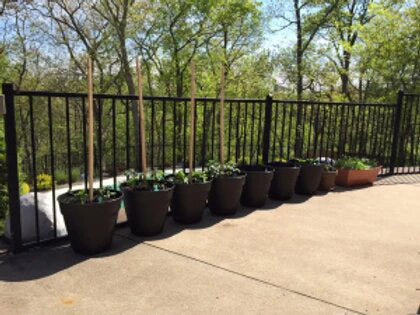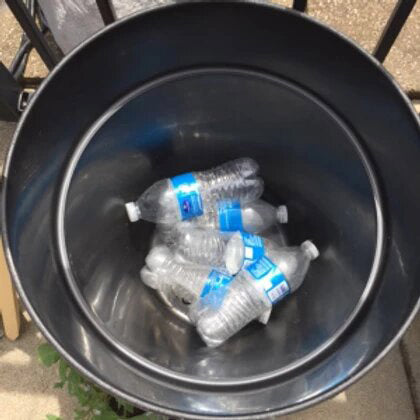Container Garden Guide
I am a huge fan of container gardening. It's super managable, produces well and looks really nice on your back porch, specific area in your yard or if you need to work it into your patio landscaping look in pots setting around you can do that too!
It's time to start thinking about your flowerbeds, herb and veggie garden.
Our home is more towards the city and on a mostly shaded bluff and it's not very conducive to a small traditional garden or raised beds like I had at our old home. We have a nice sunny patio area so I wanted to be able to bring a portion of the farm garden to our home so when cooking dinner I will be able to go outside and have some fresh, home-grown vegetables to cook up or add to a salad.
This type of gardening, known as "container garden" or "patio garden" has gained much popularity over the last few years. It allows those that have tight yard spaces or perhaps no yard at all a chance to grow their own fresh produce on a much smaller and manageable scale.
Below is a peek into my planting-palooza to create our patio garden.

First you want to think about what vegetables/herbs you like to eat. Don't plant things you won't eat.
Sounds simple but trust me, it's easy to find yourself wanting to be the next great gardener when you're 4 aisles deep in plants at the local nursery!
People often get excited and want a huge patio garden and then realize they can't keep it up and it falls to the wayside and then it's just taking up space and looks like nothing but containers full of weeds. It's not so much the time it takes because with a small patio garden it's only a few minutes a day but it's a few minutes a day..everyday... for the next 4-5 months. But trust me...that time will be well worth it!! You will absolutely enjoy the fruits of your labor!
Certain vegetables are better for container gardens. The "Top 12" are:
- Beetroot
- Carrots
- Zucchini
- Cucumbers
- Bush or Pole Green Beans (I've had the best luck with Bush varieties) Lettuce
- Spinach
- Peas
- Onions
- Radish
- Swiss Chard
- Tomatoes

For my garden, I planted 8 tomato plants (4 varieties) tomatoes can be tricky & you need to start months ahead to start from seed so I opt to buy them at the nursery or garden center, 8 green beans from seed, 3 bell peppers from seed (you can also choose to start from plants too) and 9 types of herbs.
Yes, I know peppers are not in the "Top 12" listed but I've had good luck with them. I like to purchase plants in 'Jiffy Pots' they are biodegradable and you are not left with lots of empty plastic pots to dispose of. Just cut off the plastic wrapper, remove the bottom portion of the pot and plant the whole thing and it turns into soil.
Here is what you will need:
- Pots-at least 18" deep for vegetables and 8" deep for herbs
- Plants
- Seeds/Plants
- Pole stakes (if planting tomatoes or pole beans)
- Gardening gloves- I recommend the kind with rubber palms.
- Trowel(small shovel)
- Vegetable fertilizer
- Potting soil
- Plant markers
- 1 Bag of Mulch- optional
When shopping for containers/pots I like to buy plastic. They are light, easy to store, don't scratch or leave marks on your concrete, and won't break. They are also very cost friendly.
A popular choice is galvanized steel strictly for the look. Which I agree it looks great. However, galvanized steel gets very hot and can dry out much faster and from past experiences, the plants don't grow as well in them. Plus, they can be pretty costly.
Clay pots also look nice but they are heavy, will leave marks if you push them around on your patio, dry out quickly and will break if knocked over or if you store over the winter and they get knocked over they will break.
When shopping for potting soil, I buy just that POTTING soil. It helps maintain moisture control and provides the proper growing medium for container and patio gardens. My favorite is Miracle Gro Moisture Control Potting Mix.

Proper drainage is key with your garden. It keeps the excess water from a large rain or from accidental over-watering off the plant and allows it to be carried away from the soil. In my opinion the best choice is to recycle soda cans or water bottles and place them in the bottom of the pot. This is a great way to recycle them as well as it keeping your pots light if you have to move them around. Rocks are another option but again, it can be heave if you need to move the pots around.

This allows drainage and also fills the bottom portion which will require less soil to fill the pot.
After you have your pots and empty bottles or cans prepped and your pots are in the spot you plan on keeping them add in the potting mix. Fill it almost to the top then press it down lightly. (Once you water it it will sink down a few inches so fill it up!)
It is much easier to fill the pots where you plan to keep them so it's less moving and carrying them around when they are full. :)

Next, add your plants. Remove the wrapper and the bottom if you have jiffy pots and lightly loosen the bottom roots.
If you purchased plants in plastic pots, remove from the pot by holding plant at base and turn upside down and lightly shake to loosen plant. When plant is out of the pot, gently loosen the roots at the bottom and sides by using a gentle tearing type motion.
This ensures that your roots will take off in the new soil and not become 'root bound' and want to keep growing in circles like it was use to doing in the pot.

Once you have your plants in the soil, sprinkle the soil with the vegetable fertilizer then water the plants. I like this vegetable fertilizer, it’s organic and is people & pet safe. This can be found at Home Depot and most garden centers:

Give them a good soak to be sure the roots are finding the new soil and they can start digging in that new fresh dirt! If you planted tomatoes, this is when you would also add the tomato stake. It's important to do this now so you don't disrupt any root growth later on.
You can see in the previous photo, I use 1 stake per 2 plants. I will tie them to the stake using strips of an old t-shirt once they begin to grow taller. This will prevent them from getting too heavy and leaning over and breaking as they grow.
As I mentioned earlier mulch is an optional purchase. It won't take much so a smaller bag will do the trick. Mulch will help keep weeds down, hold moisture in and give your plants a really nice finished look. :) It's also good to keep the soil from splashing up on the plant when you water. Which can cause diseases in the plant if it becomes 'suffocated' by the soil. It's best to water in the early morning before the heat of the day and also to water low, at the soil level. Not water from above getting the plants wet. This helps prevent sun scorching, disease and keeps aphids and other garden insects away.

Above, you can see the tomato plants staked and mulched ready for me to pluck yummy fruit from! Be sure to stake them at the time of planting. You don't want them to get big then you stake them and will be pushing the stake through the root system that has been established.
For plant markers--keep it easy.
People buy expensive fancy ones with intention of using them again but rarely do. These little 'people' I found at Michael's Craft store and there were around 25 in a bag for $3. I painted them with a foam sponge and then wrote in a Sharpie marker. Simple. Cheap. Easy....and I think they are cute too! You can use plastic spoons, popsicle sticks, old wooden spoons, doll rods...anything you have lying around can be repurposed for plant markers.

So, I hope with these little tricks you will give a patio garden a shot this summer! It's a lot of fun and pretty cool to walk outside, pick some green beans and cook them up for supper!
For any questions you may have please feel free to email me at:


